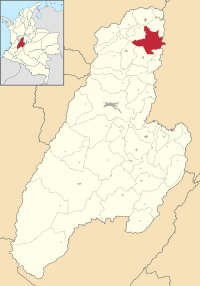Armero
This article includes a list of references, related reading, or external links, but its sources remain unclear because it lacks inline citations. (November 2017) |
Armero | |
|---|---|
 Location of the town and municipality of Armero in the Department of Tolima | |
| Coordinates: 4°57′48″N 74°54′20″W / 4.96333°N 74.90556°W | |
| Country | Colombia |
| Region | Andean |
| Department | Tolima |
| Established | 1886 (as Guayabal) |
| Government | |
| • Mayor | Carlos Alfonso Escobar Peña (Liberal Party)[1] |
| Area | |
| • Total | 440.5 km2 (170.1 sq mi) |
| Elevation | 285 m (935 ft) |
| Population (2017) | |
| • Total | 11,724 |
| Time zone | UTC-5 |
| Website | http://www.armeroguayabal-tolima.gov.co/index.shtml |
Armero, or Armero-Guayabal, is a municipality in the Tolima Department, Colombia. According to the National Department of Statistics of Colombia, 12,852 lived in the town in 2005. Its median temperature is 27 °C. It was founded in 1895, but was not officially recognized as the seat of the region until 29 September 1908, by President Rafael Reyes. The town was originally named San Lorenzo. In 1930, the name was changed to Armero in memory of José León Armero, a national martyr.[2]
Because the region became the main cotton producer in the country, the city was called Colombia's White City. It was a prosperous agricultural area until 1985.
The original seat of the region was destroyed on November 13, 1985, after an eruption of the Nevado del Ruiz Volcano produced lahars that buried the town and killed about 23,000 people. Approximately 31,000 people lived in the area at the time. The incident became known as the Armero tragedy. While the destruction of the town made world news in its own right, the best known victim was Omayra Sánchez, a young girl who died after being trapped by water and concrete up to her neck for three days. After this event, the town of Guayabal was assigned as the seat of the municipality of Armero, rendering Armero a ghost town.
The survivors were relocated to the towns of Guayabal and Lérida where they received housing and money, though little was done in aiding the survivors in reconstructing their lives.
In the area where the city was located, survivors created an extensive cemetery. Where each one had a house, they constructed a tomb with an epitaph. In this way, they constructed a new symbolic city called Camposanto.
Armando Armero is a foundation set up to bring social and economic development to a zone that has been devastated in the aftermath of the last eruption of Ruiz. It has created the Centro de Interpretación de la Memoria y la Tragedia de Armero, the first Memory Interpretation Center of a Natural Catastrophe in the world located exactly where the events occurred. There are memorial sites at each of the important places of the city (such as hospitals, parks, and theaters) near the ruins. In those, visitors can learn about the city as they existed before the tragedy.
References
- ^ Template:Es icon Colombian Registry of the Civil State: 2007 election results[permanent dead link]
- ^ "Armedo, Colombia". Ghosttown Coffee. 1 April 2014. Retrieved 13 November 2014.
External links
![]() Media related to Armero Guayabal at Wikimedia Commons
Media related to Armero Guayabal at Wikimedia Commons
- Template:Es icon MSN Encarta: Armero Guayabal (Archived 31 October 2009)
- Template:Es icon Armando Armero organization
- González, Francisco (2003). Epitafios, algo de historia hasta esta tarde pasando por Armero.Bogotá, Ediciones Bartleby, ISBN 958-96369-4-2


